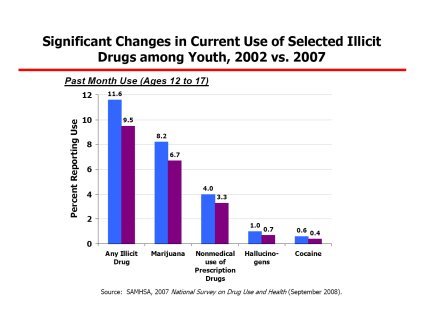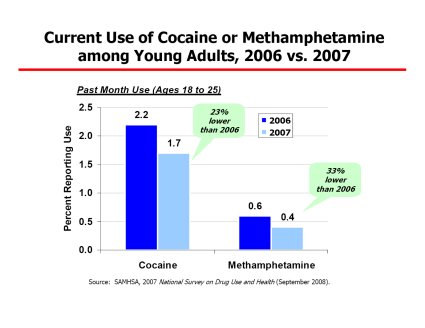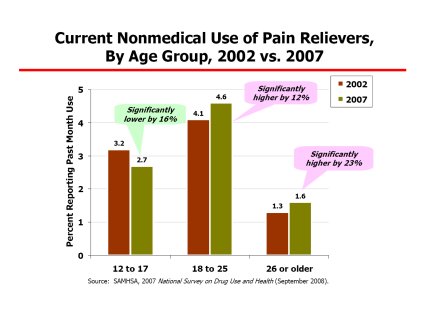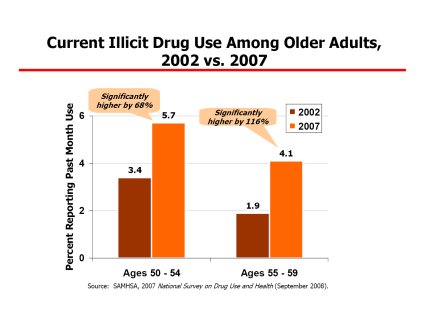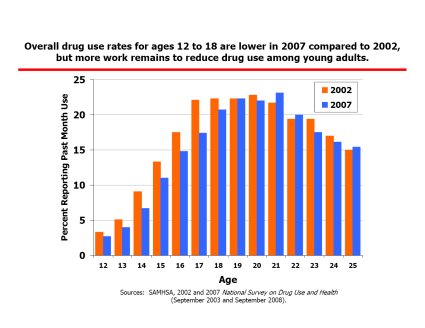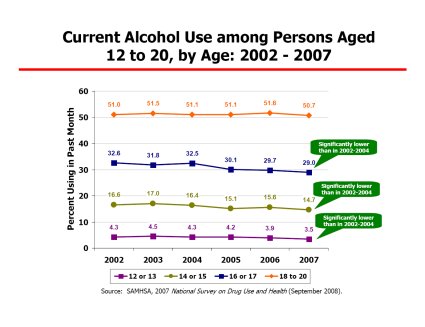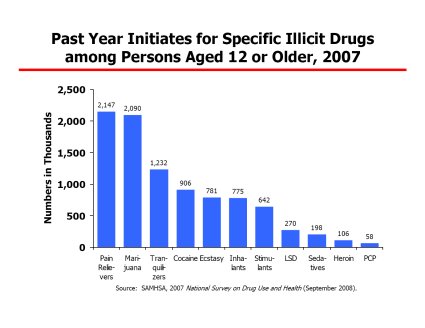Press Release |

|
| Embargoed for Release | Contact: SAMHSA Press |
Office, 240-276-2130 |
www.samhsa.gov |
New National Survey Reveals Cocaine, Methamphetamine Use Drop among Young Adults; Prescription Drug Abuse Increases
Youth Substance Abuse Declines from 2002 to 2007
Cocaine and methamphetamine use among young adults has dropped significantly over the past year, while abuse of prescription drugs has risen, according to the nation's largest substance use assessment, the 2007 National Survey on Drug Use and Health (NSDUH). The report also showed a spike in drug use among 55-59-year-olds, as baby boomers entered that age range.
Cocaine use among 18-25 year-olds dropped 23 percent (to 1.7 percent), while methamphetamine use among young adults fell by a third (to 0.4 percent) between 2006 and 2007, said the report by the Substance Abuse and Mental Health Services Administration (SAMHSA). The survey was released today at the start of the 19th annual National Alcohol and Drug Addiction Recovery Month.
Historically, young adults have had the highest rates of substance abuse.
Among youth ages 12-17, there was a significant decline in overall past month illicit drug use, from 11.6 percent in 2002 to 9.5 percent in 2007. Reductions in youth drug use occurred for nearly every type of illicit drug, including marijuana, cocaine, hallucinogens, LSD, Ecstasy, prescription-type drugs used nonmedically, pain relievers, stimulants and methamphetamine.
Current marijuana use among this age group declined from 8.2 percent in 2002 to 6.7 percent in 2007. Most of the decline occurred between 2002 and 2005.
The level of alcohol use also dropped among those aged 12 to 17, from 17.6 percent in 2002 to 15.9 percent in 2007. Similarly, the rate of cigarette use among this age group diminished from 13.0 percent in 2002 to 9.8 percent in 2007.
"These results confirm that progress has been made – particularly regarding substance abuse among younger Americans," said HHS Secretary Mike Leavitt. "The report also reminds us of the importance of our efforts to provide substance abuse treatment to those in need and to encourage health care professionals to identify people who are at risk for developing substance abuse problems and intervene early."
The reductions in methamphetamine and cocaine use among young adults coincide with reductions in their use among Americans in the workforce and significant market disruptions for both drugs. In 2007, there was a 21 percent increase in the average price per gram for cocaine and a 10 percent decrease in purity.
Workplace drug test positives for cocaine dropped 19 percent in 2007 to the lowest levels in the history of this testing system. For methamphetamine, there has been a 50 percent reduction in the level of workplace drug test positives since 2005, along with an 84 percent increase in average price per pure gram and 26 percent decrease in methamphetamine purity in 2007.
Despite many positive trends, the most recent NSDUH also reveals some less encouraging data. Among young adults ages 18 to 25, the level of current nonmedical use of prescription pain relievers has risen 12 percent (to 4.6 percent in 2007). In addition, the level of current illicit drug use among those aged 55 to 59 more than doubled, to 4.1 percent in 2007, confirming concerns that baby boomers have continued their higher levels of substance abuse as they age.
"Our efforts against methamphetamine, cocaine, and other illegal drugs are working," said John Walters, director of National Drug Control Policy. "The markets for these poisons are shrinking, and the deadly grip they hold on the lives of individuals, families, and communities is being countered. But when it comes to prescription drugs, we can not afford to re-live the painful experiences we've had with illegal drugs. We must act quickly to increase awareness of the dangers of prescription drug abuse, decrease the illegal diversion of these products, and shore up safer practices for their prescription and distribution."
The 2007 NSDUH report also provides extensive data on mental health issues. The report says 24.3 million Americans aged 18 or older experienced serious psychological distress over the past year, and 16.5 million Americans had suffered at least one major depressive episode during this period.
The mental health and substance abuse components of the report also highlight the association between these public health problems. For example, in 2007 adults 18 and older who had experienced a major depressive episode in the past year were more than twice as likely as other adults to have used illicit drugs during that time (27.4 percent vs.12.8 percent).
"The survey shows the tremendous progress communities, families and individuals across America have made in reducing substance abuse among young people, said SAMHSA Acting Administrator Eric Broderick, D.D.S, M.P.H, a rear admiral in the U.S. Public Health Service. "It also provides critical information that will help guide the future direction of our substance abuse prevention and treatment efforts."
NSDUH is a scientifically conducted annual survey of approximately 67,500 people throughout the country. Because of its statistical power, it is a primary source of information on the levels of illicit drug, alcohol, and tobacco use as well as certain mental health conditions.
The complete survey findings are available on the SAMHSA Web site at http://oas.samhsa.gov/NSDUHlatest.htm.
National Alcohol and Drug Recovery Month recognizes the accomplishments of
people in recovery, the contributions of treatment providers and advances in
substance abuse treatment and recovery throughout the nation. Electronic
versions of Recovery Month materials are available at www.recoverymonth.gov. The
kit is downloadable at
http://www.recoverymonth.gov/2008/kit/pdf/Entire%20Recovery%20Month%20Kit.pdf.
SAMHSA is a public health agency within the U.S. Department of Health and Human Services. The agency is responsible for improving the accountability, capacity and effectiveness of the nation's substance abuse prevention, addictions treatment and mental health services delivery systems
###
